Pickletown
"A little town within a Little Town." That is how a former resident of Pickletown described the place where he grew up. Pickletown was never an actual town, and it was never within the city limits of Littleton. But it was a community in the truest sense. It encompassed more or less the area of small, mostly five-acre tracts on either side of Pennsylvania Street and along the east side of Grant Street, south of Orchard Road to Poplar, (now Caley), Avenue and the Highline Canal. Pickletown may have originally got its name from the delicious cucumbers some residents grew. The cucumbers and much of the other produce from the gardens and orchards there were sold to the Merry Canning and Pickling Company, started by Avery and Charlotte Gallup in 1891 at Nevada and Low streets in downtown Littleton. Some old timers said that earlier there was a pickle factory right in Pickletown on Pennsylvania Street.
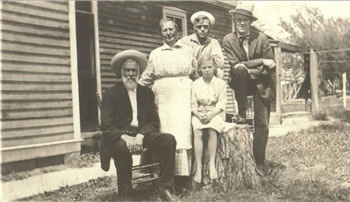
The Danfords, from left to right: Melvin, Ada, grandchildren Ernest and Clara, and extended family member Sam Synder, c.1919.
The tracts were probably first platted as Orchard Addition by a Mrs. A. G. Whitmore on November 19, 1888. Some of the earliest known residents were William A. Beers and his family of five daughters. They had come to Colorado from Kentucky in 1892 for Mrs. Beers' health. She died two years later. The family continued to live in Denver where Beers was a pressman for The Denver Post and the Rocky Mountain News. In 1897 they moved to 6046 South Pennsylvania in Littleton so the girls could live in the country. Apparently Beers continued to maintain an apartment near his work, while the girls almost independently ran the small farm. They raised irrigated alfalfa, and probably a garden, chickens and bees, before moving to Jefferson County in 1902 where the sisters started their famous dairy. The Owens family also lived on the east side of Pennsylvania during the time the Beers were in Pickletown.
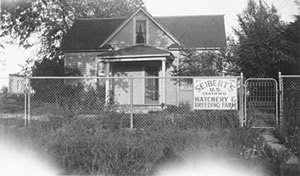
Front of the Seibert home with advertisement for their hatchery, c.1940.
In 1920 or 1921 George J. Pech bought the Danford home, the second house south of Orchard on the east side of Pennsylvania. 1924 brought Robert Seibert and his family to what is now 6000 South Pennsylvania, (east side). Their youngest child, Ellen Seibert Todd, was born there in 1933. In 1988 Ellen encouraged neighbors and former neighbors to write down their reminiscences of what life was like in Pickletown. The stories that she collected are on file at the Littleton Museum and are the source of much of the following information.
It was a place where neighbors visited on each other's front porches on warm summer evenings while their children played baseball in the road. Wives carried extra chairs over to a neighbor's living room when it was her turn to host the Home Demonstration Club. A mother making homemade ice cream would invite kids who were playing outside to come in and have some.
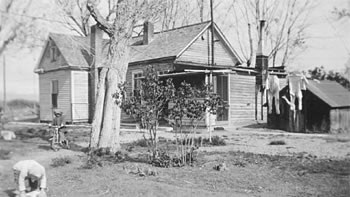
View of the back of the Seibert family home in Pickletown, 6200 S. Pennsylvania St., c.1935.
George Pech remembered truck gardens irrigated by a ditch from the Highline Canal; the vegetables were sold to Mrs. Hart at the Brookridge Dairy. Along the east side of Pennsylvania were the Gray's large poultry operation known as Graymead, (they raised white leghorns and sold eggs), the Maiers and the Almonds. There were the J. E. Murrys, Feemsters, then a large apple orchard, the Walkers' place, Claude Knox and the Don Parmenters. The Parmenters remembered other neighbors: Lloyd Wilson, Chuck Reeves and the Blanfords.
Children went to the "Broadway School" that was set back from the northwest corner of Denver Broadway and Littleton Broadway, (now Littleton Boulevard).
In the 1930s it was common to gather wild plums for jelly along the irrigation ditches, then to take a break and dangle one's feet in the cool water under the bridge on Gunzner's lane.
The Gunzner family lived from 1937 to 1954 on a large farm just beyond what was usually considered Pickletown. Their house sat at the end of a long lane lined with black walnut trees that ran south from Orchard. That lane eventually became Clarkson Street. They thought their house had been built in the 1870s and had been a summer home for a governor or senator. Whoever it was had a special love of old-fashioned yellow roses and planted them all around the house. The Gunzners raised corn, alfalfa and wheat, but their main income came from supplying milk to the Supreme Dairy in Denver.
Andrew and Erna Dransfeldt arrived in 1920 or 1921 and did not consider their forty acres to be in Pickletown either. They were on the north side of Orchard, and what was their pasture with its great ravine still interrupts Clarkson Street today. Their stucco house still stands on East Orchard flanked by the Green Oaks subdivision. Being outside the unofficial boundary did not discourage Pickletown children from sledding down the steep ravine and sometimes into Little Dry Creek.
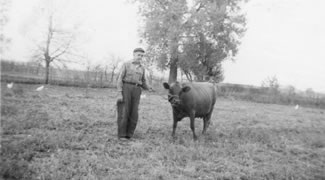
Robert Seibert in field behind his home at 6200 S. Pennsylvania Street in Pickletown, c.1943
When World War II came, Pickletown was just like any other small town in the U. S., with its victory gardens and stars in the windows for the boys in the service. The women in the neighborhood traded or borrowed stamps to buy sugar and meat. The biggest decision was when it came time to buy shoes. Only one pair a year was allowed. Little girls wanted the pretty ones, but had to get a pair that would last a year. The demand for chickens was great because they did not require meat stamps. Mr. Seibert quit his job as soda fountain repairmen for the Standard Bottling Company in Denver, and moved a little house onto their property for a hatchery. They supplied chickens for most of the meat markets in Littleton and Englewood. The sky was always filled with formations of airplanes from Lowry Field. They terrified the chickens. Chicken feed came in printed cotton sacks that were saved to make dresses.
Paul and Myrtle Johnson moved to 5900 South Pennsylvania in 1942, (southeast corner of Orchard and Pennsylvania). On their five acres they had cows and sold milk. South of them lived Claude and Ruth Sly. There was a war on, and Mrs. Sly took care of children for working mothers.
Children by then were going to grade school on Rapp Street in Littleton. The school district paid their fare to ride the regular bus from the corner of Denver Broadway and Littleton Broadway to the school. On cold mornings the Bakers let them wait for the bus inside their little store on that corner. The bus was overloaded with students and with the adults going to their war effort jobs at the Heckethorn Company in downtown Littleton. Most of the women had their hair in pin curls and bandanas tied around their heads.
Neighbors helped one another. When the Seiberts needed a building moved, Mr. Maier next door helped jack it up and put rollers under it. Then he used his big truck to push it to its new location. People loaned tools and farming equipment, helped build houses and stayed with a family after the death of a loved one. Children earned real wages for pulling weeds for ten cents an hour.
Herbert Johnson had moved to the northwest corner of Pennsylvania and Orchard sometime before 1920. There he had a large apple orchard and sold apples in Denver. He and his wife were described as totally self-sufficient on their ten acres with a flowing artesian well of warm water and big cistern. Local boys caught frogs from the reservoir to scare other children in the neighborhood. The Herbert Johnsons were remembered as being very frugal. They had a large vegetable garden and lots of strawberries, a chicken house, a hay building and a barn. The rest was in alfalfa irrigated from the well. Mr. Johnson hauled his cut alfalfa in from the field in a wheelbarrow and sometimes yelled at his cow in Swedish.
Ellen Seibert Todd says when she grew up, (1930s and 1940s), there were no houses on the west side of Pennsylvania between Herbert Johnson and H. H. Post. The Post house was said to have been an old barn that had been turned into a large house. Mr. Murray had a hay field along there. Then came the Ruptacks and the Daniel family. Daniel raised chickens, "but not like the Gray's poultry farm," said George Pech.
But H. H. Post also went into the chicken business in a big way, says Ellen Seibert Todd. Her brother, Bob Seibert remembered that one cold January night the brooder house stove on the Post farm exploded and the resulting fire destroyed most of the poultry operation. After the Posts moved away, the E. T. Pollys moved into the Post house, followed later by the Hathaways. The house was remodeled and added to until it became the showplace of the neighborhood by 1988.
At the south end of Pennsylvania were Leonard and Anna Mae Koefeeuw who grew oats and used the hay for sheep and a steer. The steer would be butchered and the taken to Lemcke's market in downtown Littleton. They watered the field from the Highline Canal near Caley. But their well gave only limited water for a garden.
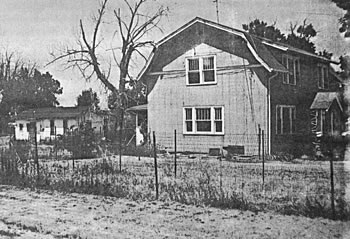
Home at 6021 S. Pennsylvania in Pickletown, date unknown.
In 1947 the Mel Nelson family rented the ten-acre former Herbert Johnson farm at Orchard and Pennsylvania. By then it belonged to Ed Rohrmann, owner of Englewood Feed Store where Nelson worked. Five acres were in alfalfa. There was a large apple orchard with 150 trees of various types. He had a flowing artesian well and a pond to hold the overflow. They had a huge strawberry and vegetable garden and also started 5,000 to 6,000 chickens at a time for the Colorado Hatchery. The neighborhood became very excited when the Nelsons were expecting a baby. Pickletown had not had a new baby for a long time. The ladies gave a baby shower. Mr. Nelson helped Bob Seibert find a job when he came back from the Korean War and took him back and forth to work until he was able to get a car.
One elderly couple lost their housekeeper and suffered because the wife, who had married late in life, knew very little about cooking. The husband was delighted when frozen foods came into the supermarkets. A neighbor always had a little oatmeal left over from breakfast and would take it down for him.
Grant Street lies a block west of Pennsylvania. The John Hoaglands had bought their land and house at the corner of Orchard and Grant about 1920. They had apple trees and sold cider. South of them was the Roger family who raised melons. Down at the corner of Grant and Poplar, (Caley), lived the Pelton brothers, George and Fred. George had been blinded in a mine accident, but he still repaired clocks, watches and automobiles. The McKissicks lived on the west side of Grant, across from the Peltons. North of the Peltons on the east side of the street were the Gunthers.
Water rights to the Highline Canal allowed some residents to get probably three good "runs" per year. A few people also had rights to Antero Reservoir water that was distributed through the Highline Canal. All the rest had wells, including many flowing artesian wells.
Arlet Riber said they bought the Pelton's corner lot when everything around there was still agricultural. They had horses, chickens and rabbits. Other people had cattle. But the developers were coming. "The building boom did boom after 1952," she said.
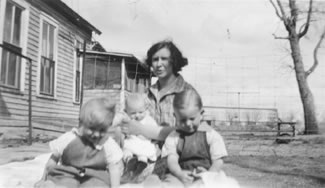
Ruth Seibert with her children at their home in Pickletown: Milton, Ellen and Robert, c.1933
As people began to sell their land, small subdivisions started to spring up where there had been large spaces of land between houses. Part of the area became known as Sherwood Park. Broadway Estates appeared south of the Highline Canal.
In 1988 those who had seen the changes in Pickletown said, "Now there is the old with the new; the streets are not neatly lined up with curbs and gutters; there are fences around the empty lots scattered here and there. There are still horses just a few blocks away from the car dealerships that line Broadway. The neighborhood had a closeness. People were always there when needed and still are. Each generation of residents takes on their titles and duties just like a blood family, and then it becomes one big extended family."
Ellen Todd said then, "Things haven't changed that much in Pickletown. The five-acre tracts are filled with houses, and most of the apple trees have been replaced with new trees. The kids still get out in the road and have a baseball game after supper on warm summer evenings. The neighbors still watch out for one another and are right there if you need help. We just don't have as much time to sit on the front porch as we used to." In 2001 she said that all the places were unique and most were kept up. Some people were friendly and some were not. But there was still help when you needed it. And the yellow roses from the old Gunzner place had spread everywhere.
Bibliography
Arapahoe County, Colorado. Plat Book A1, 1888.
Littleton (Colo.) Independent. Littleton Independent Publishers, 1888-.
Littleton Museum. Photographic Archives. Biography: Owens.
____, Vertical File: Pickletown. Written accounts of Pickletown by residents and former residents, 1988.
Thomas, Rose Dransfeldt. Idaho Springs, CO, telephone interview by Doris Farmer Hulse, January 18, 2001.
Todd, Ellen Seibert. Littleton, CO, telephone interviews by Doris Farmer Hulse, January 27 and February 3, 2001
Photographs courtesy of Ellen Seibert Todd, unless otherwise noted; for more information, contact the Museum at 303-795-3950.
Compiled by Doris Farmer Hulse
Updated June 2024 by Jenny Hankinson